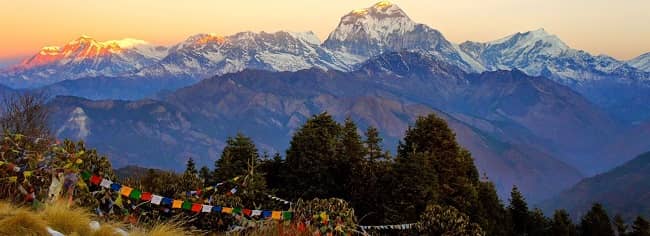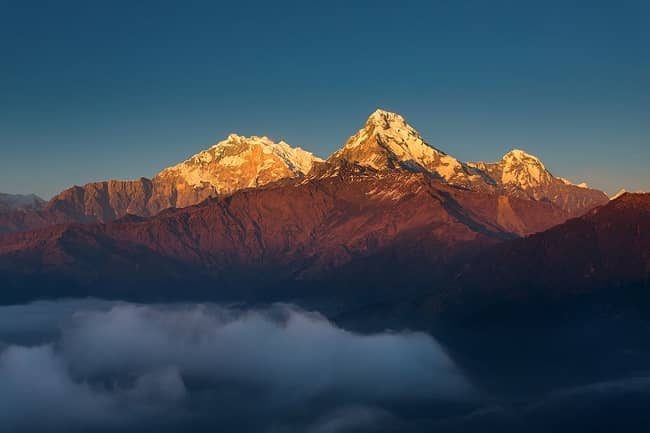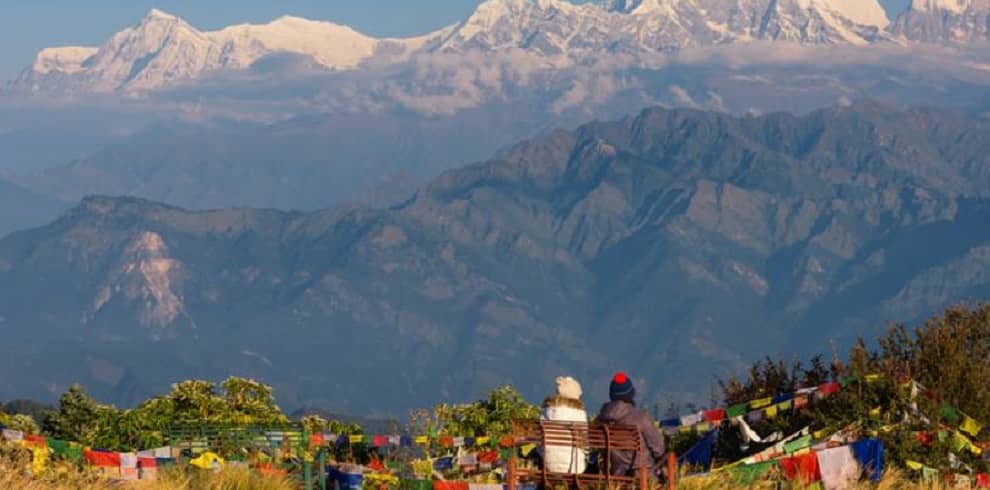Introduction To Poon Hill Trek In Nepal
Poon Hill trek is one of the easiest and best short treks in the Annapurna region. After a one-and-a-half-hour journey from Pokhara, the Poonhill hike begins in Nayapul.
The hike will take you through beautiful mountain landscapes and charming communities populated by Gurungs and Magars.
Every corner offers a breathtaking view of the high mountains, which will open up entire horizons to you as you approach the summits of your walk. The best view of the mountains and sunrise is from the lookout on Poonhill (3210m).
Your journey will be enhanced by dense rhododendron trees teeming with birds and imaging valleys.
This hike will provide views of Mt. Dhaulagiri, Mt. Annapurna I, Annapurna south, Annapurna II, III, IV, Gangapurna, Lamjung Himal, Barasikhar, Nilgiri, Tukuche Peak, Hiunchuli, and Manaslu ranges.
The Himalayan giants, Dhaulagiri (8,167m) and Annapurna (8,091m), along with a tangle of other peaks, slowly begin to materialize before our eyes as the sun touches the snow-capped tops.
This is a once-in-a-lifetime event for anyone who appreciates nature and stunning scenery. Depending on how much time you have, you can lengthen or reduce the walk.
The journey explores the middle Himalayan foothills, going through various communities and affording stunning views of the Annapurna and Dhaulagiri massifs.

This area has an unusually large range of climate zones, allowing visitors to witness a diverse diversity of plants and fauna. This location is full of Nepalese culture and tradition’s hidden gems.
Magars and Gurungs, famous for Gurkha troops who served in British and Indian armies, dominate the different lifestyles of the people who live in this region.
The walk will take you through patchwork valleys, deep mossy forests, and past icy waterfalls where you can cool yourself. As you near the summit of your trek, you will be treated to a breathtaking view of the towering mountains around every turn.
Highlights Of Poon Hill Trek In Nepal
- Mountain views include Annapurna I (8,091 m/26,545 ft), Fishtail (8,091 m/26,545 ft), Dhaulagiri (8,167 m/26,795 ft), Manaslu (8,163 m/26,781 ft), and many others.
- A look at the traditional Nepalese way of life
- On the walk, you’ll see a diverse diversity of plants and fauna.
- Villages with a strong cultural heritage, such as Ghorepani, Ghandruk, and others
- In the Annapurna region, there is a short and easy itinerary.
- Explore Nepal’s largest protected area, the Annapurna Conservation Area.

Best Season For Poon Hill Trek
Poon Hill Hike is a four-season trek with teahouses operating throughout the year. Every season may have its own set of advantages and disadvantages. As a result, we recommend this walk during the spring (March-May) and autumn (September-November) seasons.
The temperature is moderate during these seasons. Mother Nature begins to bloom in all of her glory. The mountain vistas are clearer and unencumbered. With calm weather, you can take in the breathtaking scenery all around you.
Food & Accommodation
Poon Hill Trek features very advanced routes, so you won’t have to worry too much about food and lodging. Your lodging will be in a welcoming teahouse. The rooms may be modest, with twin beds shared, but they will be clean and comfortable.
Breakfast and dinner will be served in the teahouse where you stayed. The most preferred food is dal and bhat. Noodles, soup, momos, pizzas, eggs, and even non-vegetarian options are available. In teahouses, you can request boiling filter water for drinking.
Poon Hill Trek Difficult
The Poon Hill Trek is 32 miles (51 kilometers) long and will take four days to complete. With a maximum elevation of 3210 meters, you can expect to walk for about 5-6 hours. As a result, this hike is suited for beginners. Mountain Sickness at High Altitudes is a rare occurrence (AMS).
However, you may encounter some obstacles on the approach to Poon Hill in the early morning. As a result, it’s a good idea to drink some hot water first. You must take care of everything while on the expedition. Drink plenty of water and don’t overwork your body. Get enough sleep and eat a healthy diet.
You may also visit Ghorepani Poonhill Trek-Distance, Cost, Itinerary, In Nepal – 5 Days
Overview Of Poon Hill Trek
- The Poon Hill Trek is one of Nepal’s most popular short treks, taking you through lush woods, traditional villages (including Ghorepani), and up to Poon Hill, where you can take in breathtaking views of the Annapurna Ranges, Dhaulagiri, and Nilgiri mountains.
- The magnificent panoramic mountain views from atop Poonhill of the Dhaulagiri Mountain Range, the Annapurna Mountain Range, Mt. Lamjung Himal, Mt. Manaslu, Mt. Ganesh, and several other Himalayan Ranges and the peaks are the highlights of the Poon Hill Trek.
- You will be surrounded by picturesquely terraced slopes, warm communities, lovely paddy fields, and great culture and customs of the ethnic Gurung and Magar people on both the way up and down from Poon hill.
